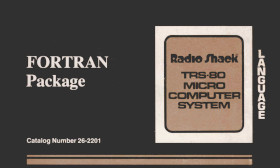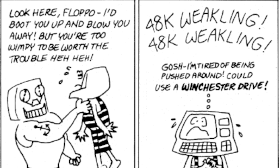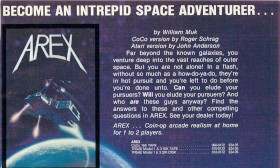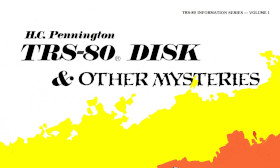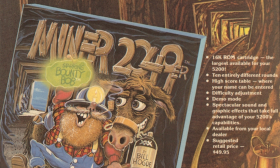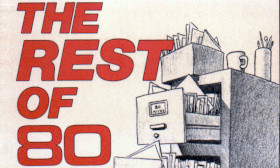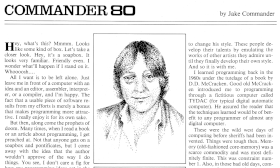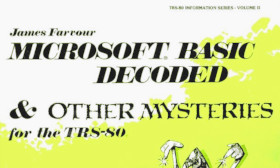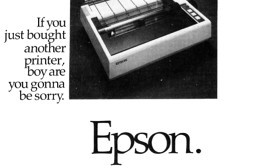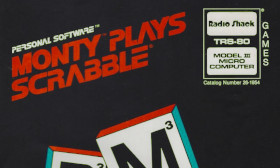Microsoft FORTRAN, also known as FORTRAN-80, was one of the most advanced programming tools available for the TRS-80. As a compiled language, it was more powerful than the included BASIC interpreter. Microsoft FORTRAN was created and sold by Microsoft for multiple TRS-80 models, although the most popular versions were sold directly by Radio Shack. Many commercial TRS-80 programs, such as The Mean Checkers Machine by Lance Miklus, were written in FORTRAN. Miklus wrote in the March 1980 issue of The S-Eighty:
FORTRAN’s advantages are numerous: it’s fast, the coding technique is protected, it has powerful library functions, it is an excellent number cruncher, its functions are complete subroutines instead of single lines, and it interfaces easily with machine language subroutines.
(Read more...)
The April 1983 issue of 80 Micro contained an article called “The Muscle Micros.” Written by the “80 Micro Tech Staff”, the article profiled “three sleek supercharged” TRS-80 Model III computers equipped with hard drives (commonly known at the time as Winchester drives). The three computers profiled were:
- The BT Hard Disk Model III Microcomputer from BT Enterprises of Bohemia, New York
- The MTI Mod III Plus from Microcomputer Technology Inc. (better known as MTI) of Santa Ana, California
- The Computex Model 326 from Computex of Houston, Texas
Much like the earlier Adcock & Johnson Model 3000, which was a Model III repackaged in a transportable case, these companies bought Model III computers from Radio Shack and then extensively upgraded them into their own branded products. The article described what made up these “muscle micros”:
(Read more...)
Arex, written by William Muk Koon Yet, was one of the last games Adventure International sold for the TRS-80 Model I and III. It cost $34.95 for both the disk and tape versions when it was released in late 1982. As with many of their other games, Adventure International adapted Arex for multiple computers:
- The Apple II version (for disk only) was written by Gordon Eastman.
- The Atari 400/800 version (for disk and tape) was written by John Anderson.
- The Commodore 64 version (for disk and tape) was a conversion by Philip Case of John Anderson’s Atari version.
- The IBM PC version (for disk only) was written by Philip Case.
- The TRS-80 Color Computer version (for tape only) was written by Roger Schrag.
(Read more...)
One of the most popular books ever written for the TRS-80 was TRS-80 Disk and Other Mysteries by Harvard C. Pennington. It was published in 1979 by International Jewelry Guild of Upland, California (a company co-founded by Pennington) for a price of $22.95. The book was an unexpected success for International Jewelery Guild (better known as IJG), at the time primarily a seller of gold coins and diamonds. The first two printings of TRS-80 Disk and Other Mysteries sold out before IJG had even received them from the printers. One advertisement described the book as “the definitive work on the TRS-80 disk system.” The manual for Super Utility described it as “a ‘standard’ reference.”
The TRS-80 Model I was less than two years old at the time, and Pennington had been one of the first purchasers. There was a great demand for TRS-80 information and Pennington wrote about many topics in the TRS-80 Disk and Other Mysteries. These included using hexadecimal and binary, a discussion of TRS-80 disk operating systems, the TRSDOS directory structure, even Pennington’s opinions of Radio Shack. William Barden, Jr. described the contents in the preface to the book:
(Read more...)
Bill Hogue, through his company Big Five Software, was known for producing some of the best games available for the TRS-80 Model I and III. Games like Galaxy Invasion and Robot Attack were legendary in TRS-80 circles. But Bill Hogue and Big Five Software’s most successful game wasn’t for the TRS-80. It was Miner 2049er, the 1984 Electronic Game of the Year. Miner 2049er was an Atari platform game with ten levels that had versions available for more computers than any other game at the time.
Here is a description of Miner 2049er from a 1983 Big Five Software flyer:
(Read more...)
In late 1982, 80 Micro magazine and the TRS-80 itself were riding a wave of popularity. Some issues of 80 Micro topped 500 pages and it was the third largest magazine in the United States, not just among computer magazines, but among all magazines. 80 Micro actively solicited articles and those enormous issues were filled largely with articles submitted by readers.
The book The Rest of 80 was another result of this abundance of material. It was a collection of articles submitted to 80 Micro, but never published. They were described as “some of the very best manuscripts ever sent to 80 Micro.” The Rest of 80 cost $9.97 when it was introduced in 1983.
(Read more...)
“Commander 80” was a column that ran irregularly in 80 Microcomputing magazine from the May 1982 to the May 1983 issues. It was written by Jake Commander, TRS-80 author, technical consultant to 80 Microcomputing, and a very frequent contributor to the magazine. Despite the fact that there were only nine “Commander 80” columns, it remains one of the best remembered columns from the magazine.
Jake Commander described “Commander 80” as “a regular pot-pourri of TRS-80 facts, ideas, and opinions” in his first column:
This is the first of a series of columns I’ll be doing every month for 80 Microcomputing, covering topics ranging all the way from software and hardware to my general opinions on whatever takes my fancy. This is an opportunity I’ve waited for — to be able to sound off and air some of my views.
(Read more...)
There were many books that documented and disassembled the TRS-80 Model I ROM, but Microsoft BASIC Decoded and Other Mysteries by James Lee Farvour was the most famous. Microsoft BASIC Decoded and Other Mysteries, volume 2 in the IJG’s TRS-80 Information Series, includes a complete overview of the Level II ROM in the TRS-80 Model I and is one of the best sources of information about the TRS-80 BASIC ROM. It cost $29.95 when it was introduced in 1981. A January 1982 review in 80 Micro said “Without a doubt, it is the most comprehensive book on Level II BASIC ROM to be published so far.”
Microsoft BASIC Decoded and Other Mysteries is made up of two sections. The first half of the book collect a wide assortment of details about BASIC, including some not commonly found elsewhere. This includes information such as reserved BASIC keywords, functions and entry points, the format used for cassette storage, even the formulas used by the BASIC math functions such as SIN and COS. One chapter covers disk operating systems, which weren’t even part of Microsoft BASIC.
(Read more...)
The Epson MX-80 was one of the first very successful consumer dot-matrix printers. It was introduced in October 1980 by Shinshu Seiki Co., Ltd. (later known as Epson Corporation) of Nagano, Japan. The Epson MX-80 was the best selling printer in the United States and Japan and became synonymous with dot-matrix printers.
The printer control language used by the MX-80 (later known as ESC/P) became an important standard that was supported by other printer manufacturers. It was a rare TRS-80 program that could print and didn’t support the Epson MX-80.
(Read more...)
Monty Plays Scrabble (catalog number 26-1954) by Ritam Corporation of Fairfield, Iowa was a sequel to their earlier Monty Plays Monopoly. It cost $34.95 and was released in 1982 for the 32K disk TRS-80 Model III. Ritam also sold a version of Monty Plays Scrabble for the Apple II. Other than color, the Apple II version was nearly identical to the TRS-80 version.
Like Monty Plays Monopoly, Monty Plays Scrabble was a “computer opponent program” allowing up to four people to play Scrabble against their computer. Unlike it, Monty Plays Scrabble was officially licensed by Selchow and Righter Co., the Scrabble trademark holder at the time. (The manual identifies the title of the game as “Monty Plays the SCRABBLE Brand Crossword Game.")
(Read more...)
